
|
|
|
|
| Photo Gallery Location: Click HERE! |
- INDEX -
| Special Report vol. 1 | The things we learn at zoos | Mr. Sagawa talked to Jack the Lizard about the aspects of animals that we can learn about. | ||
| Special Report vol. 2 | Bear's Hybernation | Zookeeper talked to Jack about the bear's hibernation in the zoo. | ||
| Special Report vol. 3 | 2008 Year of the Frog | Jack reported how Ueno Zoo participated the worldwide campaign to protect frogs and other amphibians. | ||
| Many More Animals at Ueno Zoo!! | ||||
SPECIAL REPORT vol. 2
Sleeping beauty bear
Ueno Zoo have been conducting Japanese black bear hibernation program since winter 2006. A female bear called Coo starts sleeping from middle of December and wakes up middle of March.

|
Ueno Zoo constructed three different size of room for hibernation. The smallest one is for hibernation and the others are for preparation in which room temperature is cooler than outside. In the wild, lack of food leads bears to hibernate during winter. In captivity bears usually do not hibernate because they can eat all year round. To have Coo hibernate, her zookeeper Keiko Ide, who reared Coo since she was about size of little dog, gradually decreases the portion of her food in autumn. 
Coo and Taro, the Asiantic Brown Bear at Ueno Zoo |
Get fat before sleep
“I have to be very careful about her menu. She eats all food which are usually apples and sweet potatoes available so she sometimes puts too much weight in summer. But she needs stamina to cope with harsh summer heat, so I give her dried fish for protein.
In autumn she needs as much fat as she can get to hibernate, so I add chicken sausage on her normal menu like acorns and persimmons”, said Ide.

While wild bears hibernate, they recycle their urine instead of excreting to make protein and calcium to maintain their muscles and bones. Female bears give birth and bring up new born during hibernation if they got enough foods before they sleep.
According to Ide, Coo does not eat at all and wakes up few times a day during hibernation.

Asiantic Brown Bear |
Almost survival magicWhen she woke up in spring, she lost some weight but her fur was in very good condition. “I was totally amazed her strength and Mother Nature's magic”, said Ide and satisfied the result of Coo's first hibernation. |
Do not disturbVisitors could peak the hibernation room. At first they could not see at all but once their eyes get used to darkness they could observe sleeping bear on straws. |
 You can see the sleeping Coo from this window. Be quiet... |
(Februaly 7, 2008)
SPECIAL REPORT vol. 1
 Zoo is not just a place to see animals. You can see several aspects of animals to learn about. Today, I met Mr. Yoshiaki Sagawa who works in the education dept. at Ueno Zoo.
Zoo is not just a place to see animals. You can see several aspects of animals to learn about. Today, I met Mr. Yoshiaki Sagawa who works in the education dept. at Ueno Zoo.
Shall we scoop up!
 Ueno Zoo accepts students from more than 100 elementary and high schools every year. They learn about animals, biology, ecology and zookeeping from the zookeepers. Especially the students from Tokyo district have privilege to experience the 3-days program.
Ueno Zoo accepts students from more than 100 elementary and high schools every year. They learn about animals, biology, ecology and zookeeping from the zookeepers. Especially the students from Tokyo district have privilege to experience the 3-days program.
 Through this program, the students clean the pens, cages and corrals, feed animals, and so on. The most popular animal in this program is elephants.
Through this program, the students clean the pens, cages and corrals, feed animals, and so on. The most popular animal in this program is elephants.
"The zookeepers work in the team of six. So we can do our jobs and teach the students at the same time. The students may have a chance to touch female elephants to feed them. That must be once in a life time experience, isn’t it?", said Mr. Sagawa.
We are all interconnected.
|
Mr. Sagawa sometimes talks to public about his own experience as a zookeeper. The point he wants to talk about is the fact that all lives are connected to each other. "For example, the White Owls only eat fresh mice. We keep those mice alive until just before we feed the owls. It may sound brutal, but that’s one of the realities of zoo. Life and death exist together. I want the students to think about the meaning of it. Human also takes other lives to live. All lives are connected", said Mr. Sagawa. He emphasized that all of the living things are not only important as individual, but also they have own role to fabricate to complex eco system. |

|
It costs a lot.

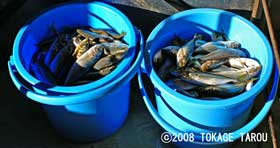
Ueno Zoo spend 300 thousands yen (about $2,900. US) for feed each day. The zookeepers need low cost food to meet the budget. For example, the raptorial such as eagle and hawk like chicken head that human don’t consume in Japan. Horse meat for lions and the Seawater Crocodiles is also at low cost, and the meat is low fat.
 The Jack Mackerels for the Californian Sea Lions and penguins are extremely fresh. Those even match human standard for sushi and sashimi. For the Western Lowland Gorillas, yoghurt is the great communication tool with their zookeepers. The zoo receives so many donations from animal lovers, too. Acorns and chestnuts are for small mammals such as the Large Japanese Field Mice.
The Jack Mackerels for the Californian Sea Lions and penguins are extremely fresh. Those even match human standard for sushi and sashimi. For the Western Lowland Gorillas, yoghurt is the great communication tool with their zookeepers. The zoo receives so many donations from animal lovers, too. Acorns and chestnuts are for small mammals such as the Large Japanese Field Mice.
Born in zoos
Now, 80% of the animals in zoos in Japan are born in zoos and institutions. For the endangered species, each zoo has vital role to increase their population, and the zoos have to work together. For instance, an Okapi loaned out to Zooracia in Yokohama city for mating from Ueno Zoo. The Western Lowland Gorilla came from Australia, and now she is expecting a baby.

Okapi |

Do the out side leaves taste better for you? |
Zoos also work for wild life conservation. The Japanese Wood Pigeon, one of the national natural monuments, live only on the Bonin Islands, 1,000 km south of Tokyo. Three birds were captured, and now the family has grown to 13 in captivity.
The Giant Panda is the one!
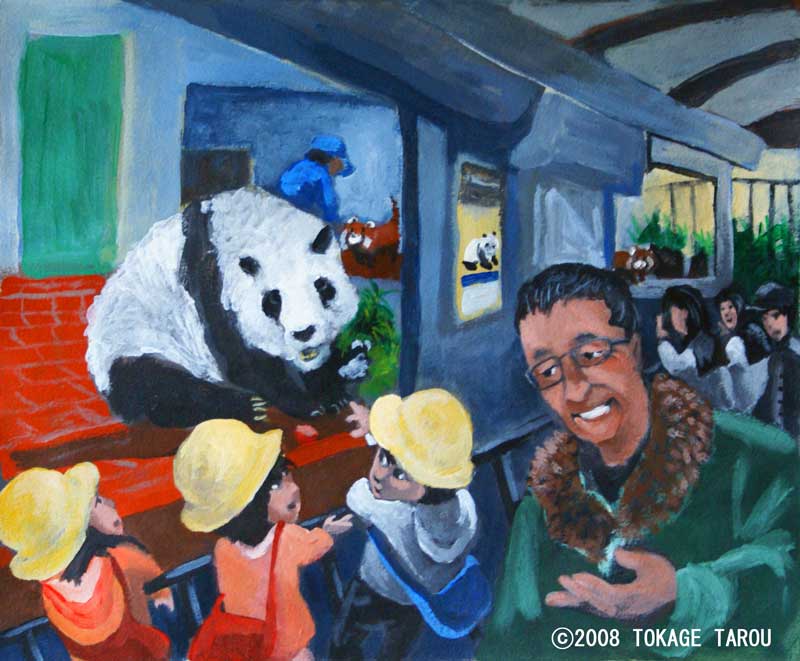
Since the very first Giant Pandas, Lan Lan and Kang Kang, were introduced to Japan in 1972, Mr. Sagawa had worked as their zookeeper for 23 years. He’d taken care of not only these two pandas, but also all the others including the currently exhibited Ling Ling(1). During that period, he witnessed the birth of three baby pandas, Chu Chu, Tong Tong and You You.
"People believe that I know about the Giant Panda very much, but I know only about the pandas of Ueno Zoo. Each individual is different from others, so statistics or scientific studies do not help sometimes. When you have had enough experience as a zookeeper, you can see the character of individual animal and how to get along with those. Sometimes you cannot. For instance, I could not get credit from one elephant. I was sure that I did not do anything wrong as zookeeper. It’s just nature. That’s the interesting part of being a zookeeper."
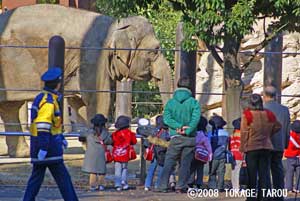
I asked what his favourite animal is. He quickly responded,
"Well, after all, the Giant Panda is the one."
Thank you very much for the great story, Mr. Sagawa.
| (1) |
Ling Ling past away on April 30, 2008. He was 23 years old. That can be converted to human’s 70 years old. Ling Ling, we’ll remember you long. |
(Februaly 8, 2008)
SPECIAL REPORT

2008 Year of the Frog
The environment has been dramatically difficult to live for amphibian. As the matter of fact, 165 of amphibian species are believed to be extinct, and 50% of 6000 described amphibian species are on the verge of extinction. (1)
Amphibian Ark is leading zoos, aquariums and botanical gardens to initiate the campaign to protect amphibian and announced "2008 – The Year of Frog".
The main goal of the campaign is to generate public awareness and understanding of the amphibian extinction crisis which represents the greatest species conservation challenge in the history of humanity. (2)
| (1) | http://www.amphibianark.org/statistics.htm |
| (2) | http://www.amphibianark.org/yearofthefrog.htm |
Four institutions (Ueno Zoo, Tama Zoo, Inokashira Zoo and Kasai Rinkai Aquarium) in Tokyo have taken part in the campaign.
Today, Jack the Lizard visited Ueno Zoo to find out what the zoo has started to protect amphibians.
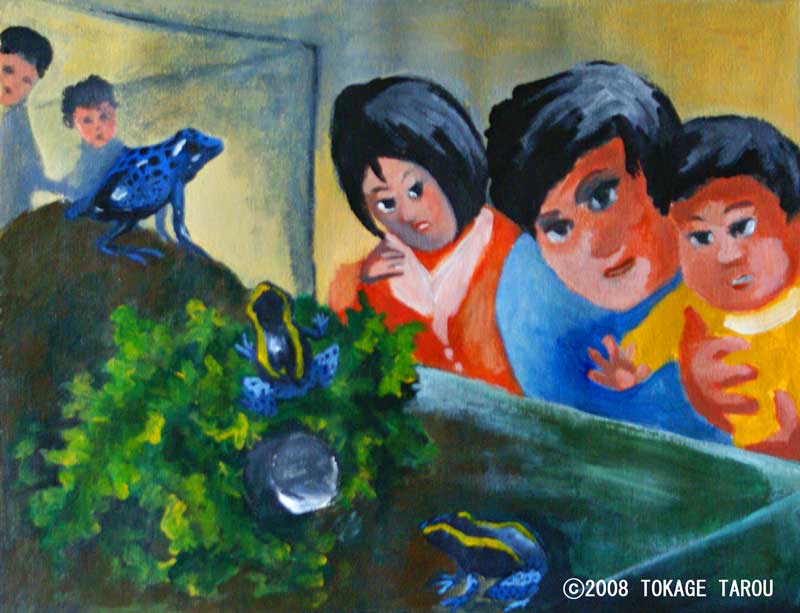
What is the serious threat?
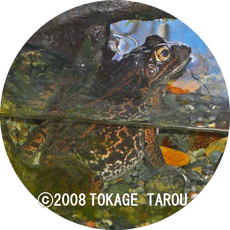 Batrachochytrium dendrobatidis (hereafter Bd), a type of chytrid fungi, was found in 1999. Bd infects amphibians and causes the fatal disease, chytridiomycosis. Since Bd is discovered, the number of amphibian has been dramatically decreasing. For example, 8 Australian indigenous frogs have been already extinct.
Batrachochytrium dendrobatidis (hereafter Bd), a type of chytrid fungi, was found in 1999. Bd infects amphibians and causes the fatal disease, chytridiomycosis. Since Bd is discovered, the number of amphibian has been dramatically decreasing. For example, 8 Australian indigenous frogs have been already extinct.

Bd was found in Japan in December 2006 from a frog in captivity. It is critically important not to spread Bd to the wild. To prevent Bd from spreading, it is very important to keep your pet frogs clean and sterilize its’ tank. If your pet frog was dead, the body must be burnt. Never bury a dead one in soil outside. It is essentially important to protect Japanese native frog species.
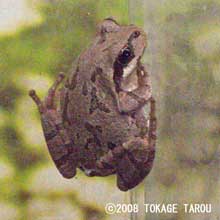
|
They are everywhere, aren't they?Ueno Zoo has about 50 different amphibian species now. Most of them are exotic frogs and newts from other countries. To participate The Year of Frog, the zoo focuses on the Japanese indigenous. Generally speaking, it was assumed that the frogs are commonly everywhere. Therefore rearing Japanese frogs in zoo is quite new project. First, the project team started collecting Tokyo Daruma Pond Frog (Rana Porosa) and Tokyo Salamander (Hynobius tokyoensis). The members went to the upper Tama River in Itsukaichi city in May. Collecting specimens was not easy. You cannot collect the eggs are connected to each other, not suitable for collection because their genes are similar. It is hard to catch dult frogs because they auickly jump to escape. So the numbers of the tadpoles were collected from different mass of eggs. |
Let’s take care of the frogs. We need to know how.
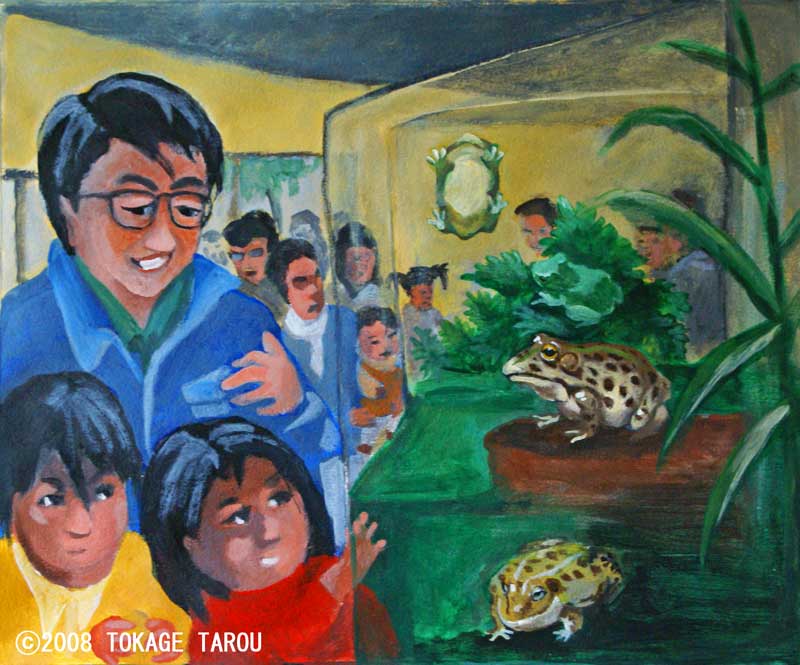
Takahashi explains us about Tokyo Daruma Pond Frog
"We still don’t know exactly how much space is necessary for a pair of frogs. It's not easy to give them a big space in the zoo facility. If it is too small, the frogs would hurt each other", said Takahashi, Manager of amphibian pavilion. Saito, a zookeeper, said, "Tokyo Daruma Pond Frog, a kind of True Frog, has strong power to jump. Unfortunately they don't recognize the glass of tank. When they panic, sometimes they collide with the glass and get hurt themselves." He pointed out the difference of the way to take care of frogs compare to Axolotl and Kasumi Salamander (Hynobius nebulosus) which do not move a lot.

600,000 crickets are in the cases here. They are the food of amphibians and reptiles.

In captivity, the temperature and humidity is adjusted to make the frogs hibernated. Their hibernation affects their breeding in the next spring. “It is a interesting experience as a zookeeper to change their environment to start and end their hibernation”, said Saito.
We may need 6 years at least to understand the frogs’ behaviour in captivity”, said Takahashi. He thinks the breeding experience will help to keep other species such as Kajika Frog (Buergeria Buergeri) and Tago Frog (Rana Tagoi) in the captivity.
After 2008, Ueno Zoo keeps researching about frogs to protect them from Bd.
Can you tell what they are thinking?
If all the amphibians disappear fro the planet, what would be possible to happen? This is not an easy question to answer. Many of you may not mind the extinction of slimy species. The official web site of Amphibian Ark states that Amphibians are indicators of environmental health, important components of ecosystems.

Saito feeds Japanese Giant Salamander. Keeper's Talk is very popular.
Takahashi wants many people to get interested in the world of amphibian.
"Do they look gross? That’s fine. It's welcomed that at least people pay attention to their existence and have curiosity about them."
Tahakashi has loved frogs and rare some by himself when he was a child.
"Frog does not have any facial expression like mammal. I cannot tell what they think, but it is really fun to study about their behaviour. They are such little creatures, but have a complex world where they catch the pray to survive and lay little eggs for the future."
Takahashi sometimes hold lectures to introduce the ecology of amphibians at public high schools.
Beautiful Amphibian
 While amphibian glows, it metamorphoses from breathing with gill to pulmonary respiration. Frog loses its tail while four legs grow.
While amphibian glows, it metamorphoses from breathing with gill to pulmonary respiration. Frog loses its tail while four legs grow.
Axolotl is cannibalistic habit. Even in the captivity, an axolotl may get bit by its fellow and looses a leg. Believe or not, a new leg grow and the axolotl will regain the perfect body.

The ideal temperature for Axolotl is around 20 degrees.
Aince amphibian is our alive textbook to understand the biological evolution, so they are precious species. They've existed since the dinosaur's era. People also love frogs because of their vivid colour.
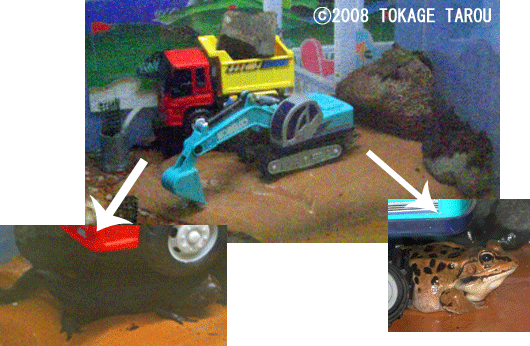
While towns are getting developed, habitats of amphibian are disappearing.
There are so many things that we don't know yet. That's the wonder world of amphibian that we do not want to loose.
 For the full size image, click on the painting.
For the full size image, click on the painting.
Opening in 1882, Ueno Zoo was Japan's very first zoo.
Believe or not, Ueno Zoo also contains a antional railway first, Japan's first monorail system.
Animals from Madagascar may be like that! |

|
|
New site, The forest of the habitat of Aye-aye, has opened in May 2009 in Ueno Zoo. You can watch the animals from Madagascar there. So, I was watching the Parson's chamaeleon and the radiated tortoise. Then forever teen-aged ladies came. After they read the information on the Parson's chamaeleon, one lady said "I see, it lives in Damagascar! Oh, wow!" (What? She must have watched the Ring-tailed Lemurs. She must have watched the display of the Baobab tree. They must have read much information on this site. Damagascar???) And then, another said "The radiated tortoise may be like that one, I guess. The pattern on his carapace is like that. That's why, I guess, the tortoise is called like that, maybe…, oh wow!" (There are many kids around overhearing you. Could you please describe the tortoise more precisely, not like that?) "Oh, wow! Look at that. That cute little one is eating very well like that!" O.K. We all love animals very much. That is all that matters. |
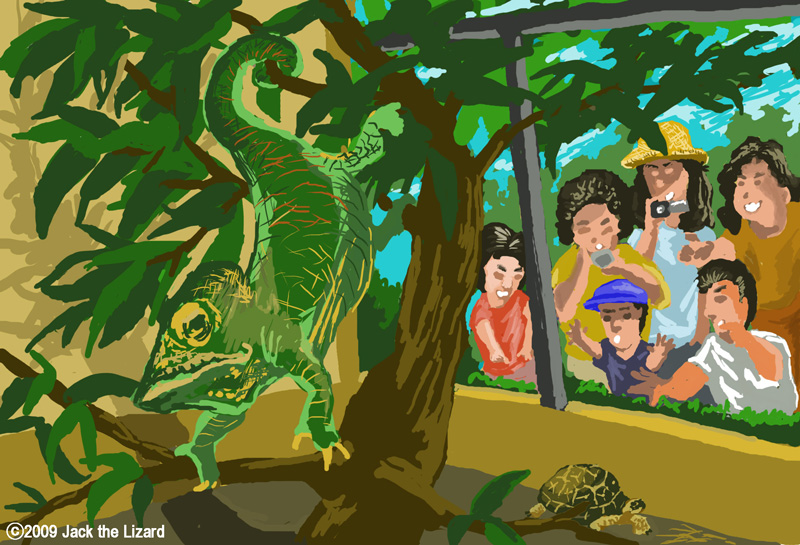
|
What the Tapirs eat?
They eat fruit, berries, and leaves - particularly the youngand tender growth...
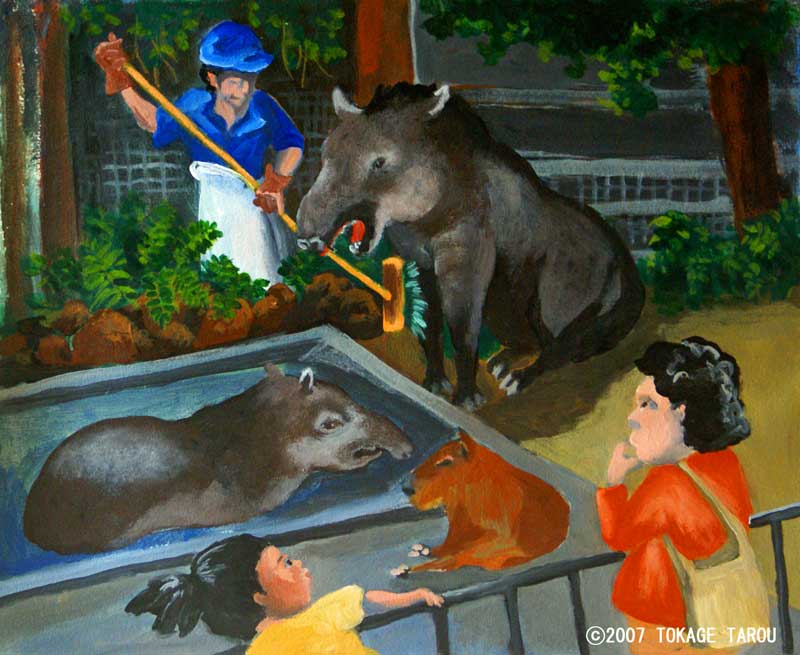
|
The Tapir is called "Baku" in Japanese. The Baku is a Japanese supernatural being that devours dreams and nightmares. Even though the boy knows it, he asks his mother "What do the Baku eat?" Do you think the mother answered her son's question? |
Trust is very important.
Elephant and Zookeeper trust during body wash is a quiet and still time.
|
Noticing the elephant lying down quietly, the amazed spectators exclaim, "Oh, they look so cute!" Do you notice that the Zookeepers are always working two or more together at a time? It's safer that way with such a powerful animal. |
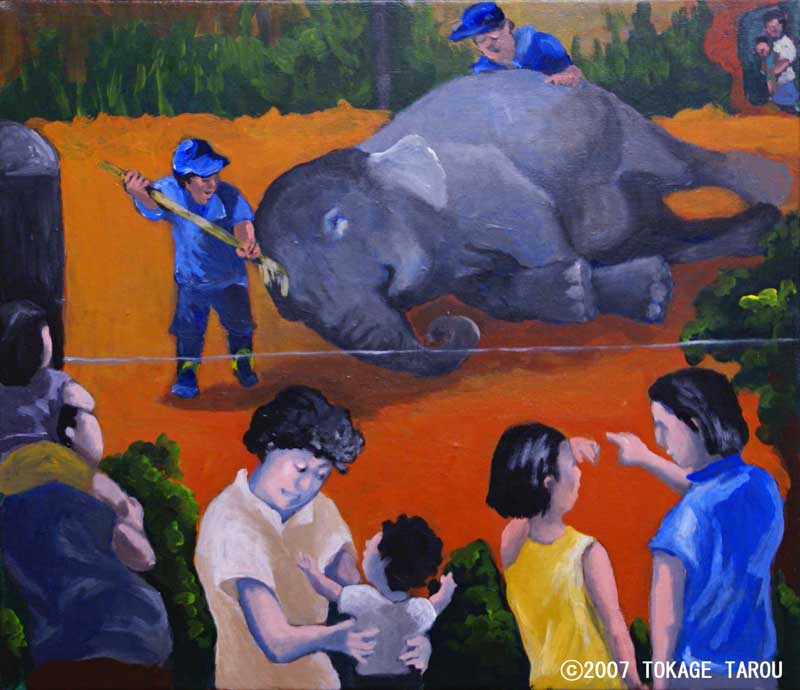
|
Hi, I'm an Abyssinian Colobus.
We had a baby in June.
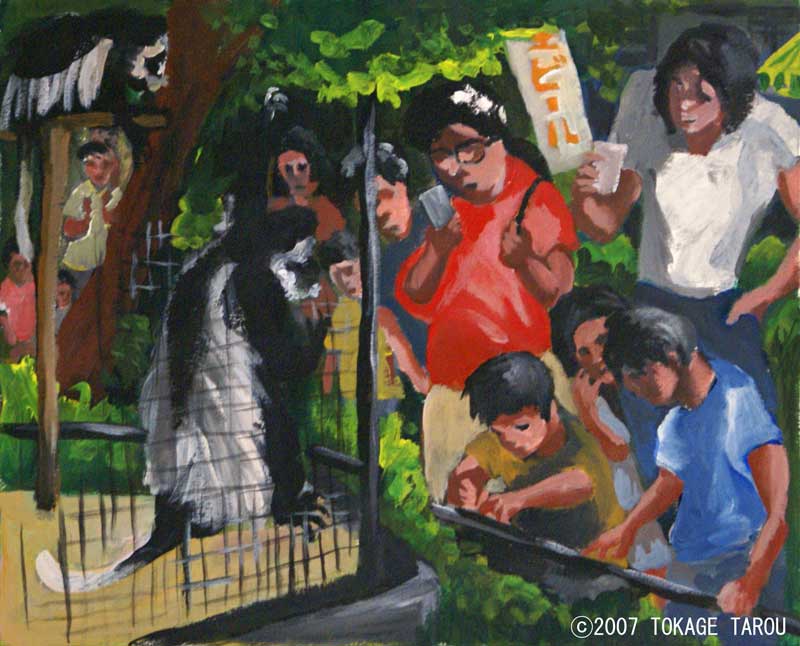
|

He is not the character from "Star Wars". According to the Ueno Zoo, their habitat is deep in the forest in Central Africa. Deep in the forest? What kind of a place is that? |
The beautiful long neck flamingos
Behold the graceful pink ballerinas!
|
I overheard a funny conversation from a couple nearby. "Hey look Nancy, the Flamingos are standing on only one leg." You guys must be kidding! |

|
Our National Animal
The Japanese Giant Salamander
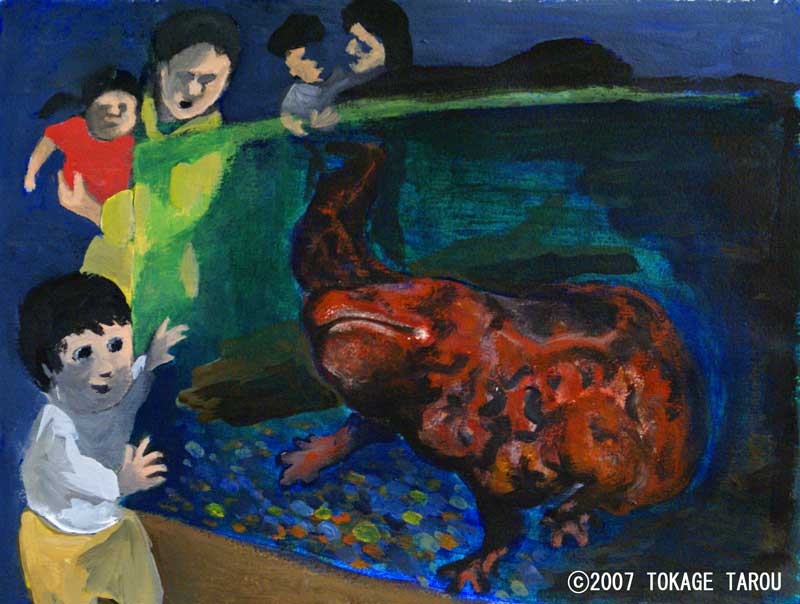
|
Although he looks pretty ugly, children and young ladies like him a lot. |
The blond haired visitors to the Giant Panda
Visitors come from all over the world.
|
Ueno Zoos is centrally located in Tokyo, so it attracts many foreign visitors. As the world's most famous animal celebrity, the giant panda draws the most enthusiastic crowds. Hey, don't forget to notice the red panda nearby too. |

|
The famous Five Story Pagoda can easily be seen from Ueno Zoo.
Let's go back a hundred years to ancient Edo.

|

Kaneiji Temple's Five Story Pagoda was rebuilt in 1939 after a fire damaged it in 1868. The tigers cannot see the Pagoda from their den, so I took them on a tour in my painting. |
Hippos' Hips.
The Hippopotamuses just show us their butts, but we like them anyhow.
|
This married hippo couple is very rare in a zoo, so these two are happy together. Usually found sleeping, visitors are still impressed with their enormous size. |
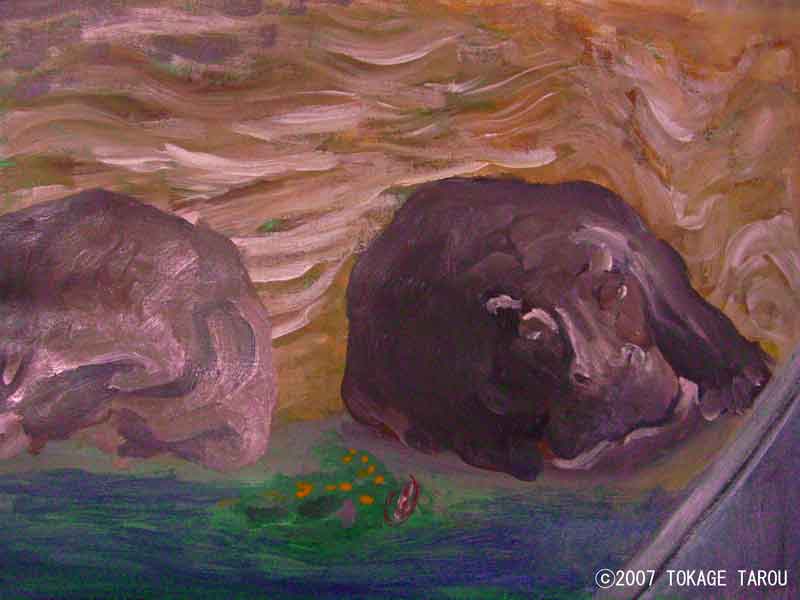
|
The waddling walk
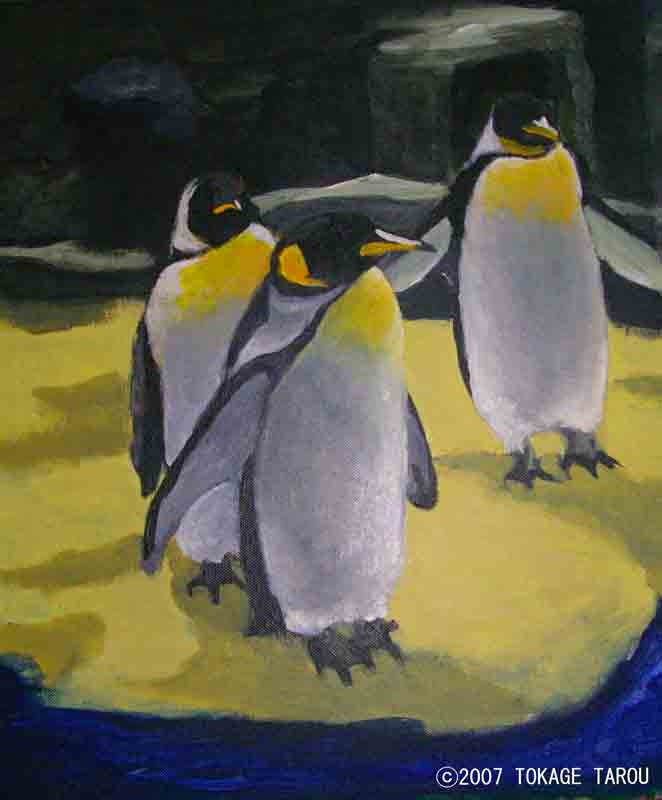
|

The penguins' waddling gate captivates and entertains their visitors. "Wow, I feel so calm watching them, don't you?" |
Like a giant cinemax screen of Ueno Zoo
The lion appears right on top of you.
|
They look so powerful, I feel so small! Why is it the boys looked scared, but the girls are enchanted? |

|